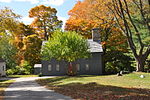Thornton, Rhode Island
Cranston, Rhode IslandItalian-American culture in Rhode IslandJohnston, Rhode IslandNeighborhoods in Rhode IslandPopulated places in Providence County, Rhode Island ... and 1 more
Rhode Island geography stubs

Thornton (formerly known as Simmonsville and Lower Simmons Village) is a neighborhood located in the north-west part of Cranston, Rhode Island on the Johnston line and extends into the Johnston side. Many of the residents of this Thornton are Italian-American, and the Feast of Saint Rocco, a Christian saint, is held every August on the grounds of St. Rocco's Church and remains an important cultural event in the community. Saint Rocco's Church was formerly on the Cranston side of Thornton on Clemence Street until the new church opened in 1951 on Atwood Avenue on the Johnston side of Thornton.
Excerpt from the Wikipedia article Thornton, Rhode Island (License: CC BY-SA 3.0, Authors, Images).Thornton, Rhode Island
Atwood Avenue, Cranston
Geographical coordinates (GPS) Address Nearby Places Show on map
Geographical coordinates (GPS)
| Latitude | Longitude |
|---|---|
| N 41.794166666667 ° | E -71.478333333333 ° |
Address
Atwood Avenue 763
02920 Cranston
Rhode Island, United States
Open on Google Maps







